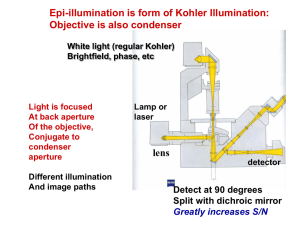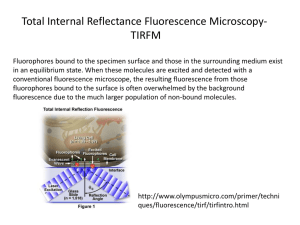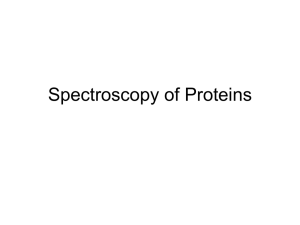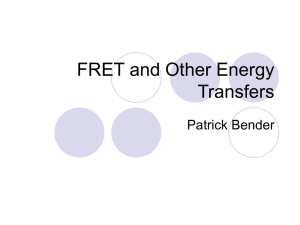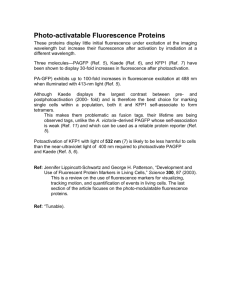Développement de quantum dots pour l`imagerie de
advertisement
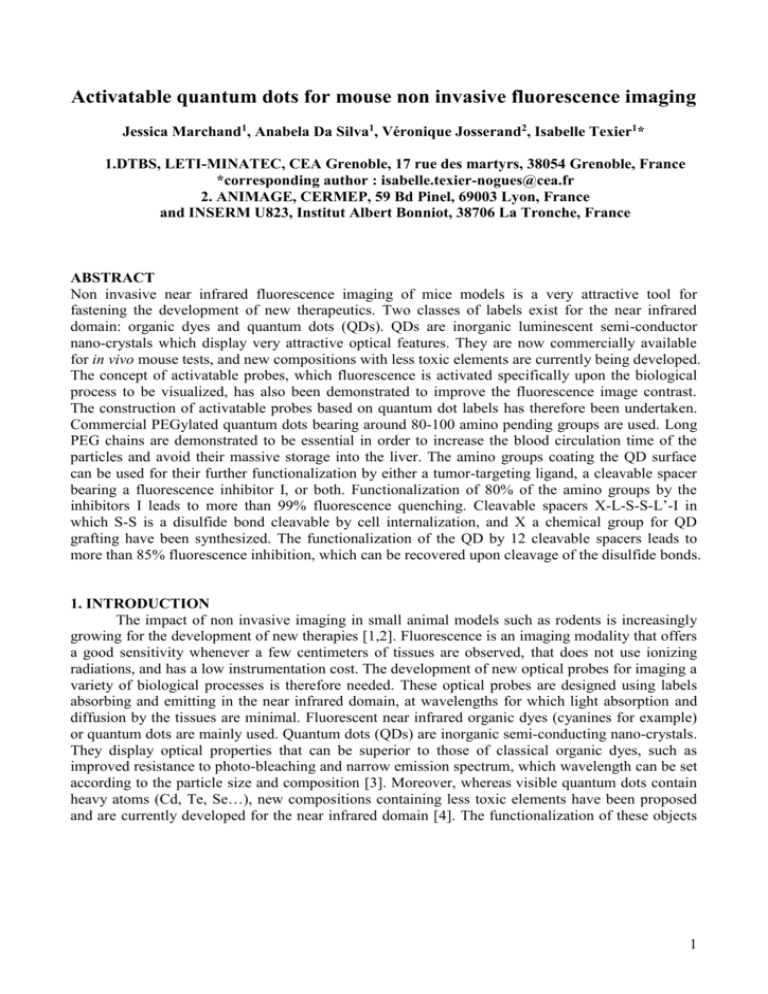
Activatable quantum dots for mouse non invasive fluorescence imaging Jessica Marchand1, Anabela Da Silva1, Véronique Josserand2, Isabelle Texier1* 1.DTBS, LETI-MINATEC, CEA Grenoble, 17 rue des martyrs, 38054 Grenoble, France *corresponding author : isabelle.texier-nogues@cea.fr 2. ANIMAGE, CERMEP, 59 Bd Pinel, 69003 Lyon, France and INSERM U823, Institut Albert Bonniot, 38706 La Tronche, France ABSTRACT Non invasive near infrared fluorescence imaging of mice models is a very attractive tool for fastening the development of new therapeutics. Two classes of labels exist for the near infrared domain: organic dyes and quantum dots (QDs). QDs are inorganic luminescent semi-conductor nano-crystals which display very attractive optical features. They are now commercially available for in vivo mouse tests, and new compositions with less toxic elements are currently being developed. The concept of activatable probes, which fluorescence is activated specifically upon the biological process to be visualized, has also been demonstrated to improve the fluorescence image contrast. The construction of activatable probes based on quantum dot labels has therefore been undertaken. Commercial PEGylated quantum dots bearing around 80-100 amino pending groups are used. Long PEG chains are demonstrated to be essential in order to increase the blood circulation time of the particles and avoid their massive storage into the liver. The amino groups coating the QD surface can be used for their further functionalization by either a tumor-targeting ligand, a cleavable spacer bearing a fluorescence inhibitor I, or both. Functionalization of 80% of the amino groups by the inhibitors I leads to more than 99% fluorescence quenching. Cleavable spacers X-L-S-S-L’-I in which S-S is a disulfide bond cleavable by cell internalization, and X a chemical group for QD grafting have been synthesized. The functionalization of the QD by 12 cleavable spacers leads to more than 85% fluorescence inhibition, which can be recovered upon cleavage of the disulfide bonds. 1. INTRODUCTION The impact of non invasive imaging in small animal models such as rodents is increasingly growing for the development of new therapies [1,2]. Fluorescence is an imaging modality that offers a good sensitivity whenever a few centimeters of tissues are observed, that does not use ionizing radiations, and has a low instrumentation cost. The development of new optical probes for imaging a variety of biological processes is therefore needed. These optical probes are designed using labels absorbing and emitting in the near infrared domain, at wavelengths for which light absorption and diffusion by the tissues are minimal. Fluorescent near infrared organic dyes (cyanines for example) or quantum dots are mainly used. Quantum dots (QDs) are inorganic semi-conducting nano-crystals. They display optical properties that can be superior to those of classical organic dyes, such as improved resistance to photo-bleaching and narrow emission spectrum, which wavelength can be set according to the particle size and composition [3]. Moreover, whereas visible quantum dots contain heavy atoms (Cd, Te, Se…), new compositions containing less toxic elements have been proposed and are currently developed for the near infrared domain [4]. The functionalization of these objects 1 has also been intensively developed in the last few years, in order to avoid any heavy atom leak and allow water solubilization and biomolecule grafting onto the particles [5,6]. Therefore, several imaging demonstrations in animals have been performed in the last few years [6,7]. The concept of activatable probe is also another breakthrough in the domain of contrast agents for in vivo imaging [8,9]. An activatable probe is composed of a near infrared emitting label linked to a fluorescence inhibitor via a cleavable chemical bond. The probe is initially non fluorescent due to the spatial proximity between the label and the inhibitor, and its fluorescence is activated by the breaking of the cleavable bound. For example, the group of Weissleder and Tung developed a series of activatable probes dedicated to in vivo enzymatic activity imaging [9-11]. More recently, we designed cRGD molecular probes for tumor targeting and cell internalization imaging [12-14]. The use of such activatable probes increases the fluorescence signal ratio between healthy and tumor tissues, and therefore the image contrast. Activatable probes based on quantum dots as near infrared labels should therefore conjugate both the optical benefits of the QD nano-particles, and the improved contrast brought by fluorescence activation. 2. EXPERIMENTAL 2.1. Materials and methods CdTe/ZnS ITK705-amino-(PEG) quantum dots (amino-QDs) are purchased from Invitrogen (Q21561MP), Cy7Q and QSY21 in their acid N-hydrosuccinimide ester form respectively from GE Healthcare and Invitrogen. Absorption and fluorescence spectra are recorded respectively using a Varian Cary 300 spectrometer and a Perkin Elmer LS50B fluorimeter. Particle hydrodynamic diameter in solution is measured using a Zetasizer Nano (Malvern Instruments). Whole-body Fluorescence Reflectance Imaging (FRI) of anesthetized Nude Swiss mice (6-8 weeks old, IffaCredo) is carried out on an experimental set-up which has been described elsewhere [15]. 2.2. Synthesis of the X-S-S-I organic cleavable spacers The synthesis scheme of the X-L-S-S-L’-I organic cleavable spacer 5, as well as its coupling reaction with amino-QDs, are represented in Figure 1. The synthesis is described briefly, more details can be found elsewhere [16]. Since organic quenchers are mostly available as the aminereactive acid N-hydrosuccinimide ester form, the commercial cystamine 1, containing both a disulfide bond and amino groups, is used as starting material. Direct attachment of the aminobearing organic cleavable spacer to carboxylic-acid functionalized quantum dots, available commercially from Invitrogen, could have been undertaken. However, ITK705-carboxylic acid quantum dots (Q21361MP) are not entrapped in a PEG coating as ITK705-amino (PEG) quantum dots (Q21561MP). Since this PEG coating is necessary to the in vivo furtivity of the nanoparticles (Figure 2) [17,18], we preferred to use PEG coated amino-QDs 6, which amino functions are transformed easily into maleimide groups using the 4-maleimidobutyric acid N-hydrosuccinimide ester cross-linker 10, to lead to maleimido-QDs 7 [19]. Boc-mono-protection of 1 leading to compound 2 is used in order to graft only one thioacetate group per linker (compound 3) for further reaction with the maleimide functions of the QD. Boc deprotection of 3 leads to compound 4, which can be derivatized with an organic fluorescence quencher, such as Cy7Q, to lead to the X-L-S-S-L’Cy7Q organic cleavable spacer 5. 2 Figure 1. Synthesis scheme of the X-L-S-S-L'-I organic cleavable spacer 5 and its coupling reaction with ITK705-amino (PEG) quantum dots 6. A. QD705-PEG750 5 min liver QD705-PEG750 3h B. liver QD705-PEG5000 5 min QD705-PEG5000 3h QD705-PEG5000 24h Figure 2. Quantum dot biodistribution in anesthetized Nude mice according to the particle coating, following their tail IV injection (20 pmol/injection). A. 705 nm-emitting streptavidine-coated QDs functionnalized by biotine-PEG750 and purified. B. 705 nm-emitting QDs coated by a PEG5000 polymer. 2.3. Coupling of fluorescence inhibitors or organic cleavable spacers 5 to the quantum dots Amino-QDs are either directly grafted with acid N-hydrosuccinimide ester fluorescence inhibitors, or derivitized by maleimide groups for coupling with the organic cleavable spacer 5, according to experimental procedures described elsewhere [16]. Surface modification of quantum dots is evidenced by absorption and fluorescence spectroscopy, along with agarose (1%) gel electrophoresis, carried out at 100 V in a TAE buffer pH 8. Gels are observed using either UV absorption analysis at 254 nm, or fluorescence analysis using a whole-body mouse fluorescence reflectance imaging device exciting at 633 nm and collecting fluorescence at wavelengths superior to 700 nm [15]. 3 3. RESULTS AND DISCUSSION 3.1. Inhibition of the quantum dot fluorescence by organic quenchers The design of biosensors using Fluorescence Energy Transfer (FRET) between visible light emitting QDs acting as either energy donors or acceptors, and organic dyes grafted on their surface, has already been described [3,20]. In the present study, near infrared emitting QDs are used as energy donors, whereas non emissive organic quenchers act as acceptors. These organic quenchers must be chosen so that their absorption spectrum matches the emission band of the 705 nm emitting quantum dots. Few organic quenchers are commercially available in the near infrared domain. The Cy7Q cyanine (Amersham) as well as the QSY21 diarylrhodamine (Initrogen) are non emissive dyes, which absorption spectra well overlap with that of the emission spectrum of the amino-QDs (Figure 3A and B). Simple mixing in solution of the amino-QDs with increasing concentrations of the two quenchers already leads to efficient fluorescence quenching, as demonstrated by the Stern-Volmer plots of Figure 3C. These plots display the ratio 0/ concentration, in which 0 and are the respective fluorescence quantum yields of the QDs alone and in the presence of the quencher. Two hour incubation of a 160 fold excess of the acid Nhydrosuccinimide ester form of these quenchers in the presence of amino-QDs, followed by chromatographic purification, leads to the grafting of around 80 fluorescence inhibitors per particle (over the 80 to 100 amino groups available), as quantitated by absorption spectroscopy. The grafting of the quenchers onto the particle surface accelerates the electrophoretic migation of the quantum dots towards the positive electrode on agarose gel in TAE buffer pH 8.0, evidencing surface modification of the QDs. The direct grafting of these 80 fluorescence inhibitors on the amino groups leads to a very efficient fluorescence inhibition of the QDs (more than 99%), for both the hydrophilic negatively charged inhibitor (Cy7Q) and the hydrophobic inhibitor (QSY21) (Figure 3D), demonstrating therefore the concept of activatable probes based on QDs as emitting labels. 3.2. Functionalization of the particles in order to design activatable probes Organic spacers X-L-S-S-L'-Cy7Q, including a disulfide bond S-S which is cleavable upon cellular internalization [12-14], a X group for grafting to the QD particle, and the fluorescence inhibitor Cy7Q, have therefore been designed and synthesized (see § 2.2). In order to control the coupling of the organic spacer X-L-S-S-L’ to both the Cy7Q organic quencher available as an acid N-succinimide ester, and the amino-QDs, with orthogonal biocompatible chemistries, the QDs are derivatized with maleimido groups, and the thioacetate function is chosen as the X group. Easy coupling of maleimido-QDs 7 with thioacetate bearing ligands has been previously demonstrated [19]. Indeed, maleimide derivatization of the amino-QDs 6 and their further functionalization by XL-S-S-L’-Cy7Q is evidenced by gel electrophoresis (Figure 4). All particles migrate towards the positive electrode, certainly because of the negative charges beard by the polymer coating the nanoparticles. The replacement of the amino-groups, positively charged as ammonium functions at pH 8, by neutral maleimide groups increases the mobility of the particles. The grafting of the X-L-S-S-L'Cy7Q organic spacers, containing negatively charged Cy7Q further favors QD migration towards the positive pole. It is noticeable that the QDs 8 functionalized by the X-L-S-S-L'-Cy7Q organic spacers 5 can only be visualized on gel using UV absorption (Figure 4A) but not fluorescence detection (Figure 4B). Particle hydrodynamic diameter in PBS solution (10 mM, pH 7.4) measured using Dynamic Light Scattering ((DLS) remains the same before and after the grafting of the organic cleavable spacers (20 ± 1 nm), since these functional groups are quite short carbon chains (10 atoms). 4 Figure 3. Inhibition of the amino-QDs (0.1 µM) by the Cy7Q and QSY21 fluorescence quenchers in PBS. A. Spectral overlap of amino-QDs emission and Cy7Q absorption. B. Spectral overlap of amino-QDs emission and QSY21 absorption. C. Stern-Volmer plots 0/ the fluorescence quencher concentration when mixing in solution amino-QDs and fluorescence inhibitors. D. Fluorescence inhibition of the amino-QDs after covalent grafting of around 80 fluorescence inhibitors onto the particle surface. start ITK705-(L-S-S-L’-Cy7Q)12 8 + ITK705 maleimido (PEG) 7 ITK705-(L-S-S-L’-Cy7Q)12 8 start ITK705 maleimido (PEG) 7 ITK705 amino (PEG) 6 + B. > 700 nm fluorescence analysis ITK705 amino (PEG) 6 A. 254 nm UV absorption analysis Figure 4. Agarose gel electrophoresis of the amino-QDs 6, the maleimido-QDs 7, and after grafting of 12 cleavable organic spacers X-L-S-S-L'-Cy7Q/particle (nano-particles 8). A. UV absorption. B. Fluorescence. 5 The organic spacers 5 designed in this work are activatable upon cellular internalization, because of the reductive medium of the lysosomal compartment which induces cleavage of the disulfide bond [12-14]. They are therefore designed to be grafted onto the QD surface along with other tumour-targeting and cell internalization driving ligands, such as the cRGD peptide [12-14], in a final tumor imaging application. That is why the demonstration of the feasibility of activatable probes based on amino-QDs and the organic cleavable spacers 5 is made using a quite small ratio of activatable spacers 5 per particle, so that the other maleimido pending groups of quantum dots 7 can be in the future derivatized by both the cell internalization activatable spacers 5, and the cRGD tumour-targeting and internalization ligands [12-14]. After 4 hours incubation of a 25 fold excess of organic spacers 5 per maleimido-QD, the number of organic cleavable spacers 5 grafted per particle is quantitated to 12 using absorption spectroscopy (Figure 5A). The emission spectra of the amino-QDs 6, maleimido-QDs 7, and QD-(L-S-S-L’-Cy7Q)12 8 are displayed in Figure 5B. The fluorescence emission quantum yields upon 590 nm excitation are measured using Nile Blue perchlorate in ethanol as a reference (fluorescence quantum yield 27% [21]). Derivatization of the amino-QDs (fluorescence quantum yield of 6: 10 %) by the maleimide groups increases slightly the fluorescence of the particles (fluorescence quantum yield of 7: 13%), whereas the grafting of 12 organic spacers 5 per particle inhibits as expected the QD fluorescence (fluorescence quantum yield of 8: 1.7%). This 87% initial fluorescence inhibition between maleimido-QD and the QD(-L-S-S-L’-Cy7Q)12 8 is similar to that obtained for other activatable probes based on organic dyes [12-14], which improvement of the contrast of tumour images has been demonstrated. Moreover, on particles 8, around 60 to 70 maleimido groups should still be available for derivatization by tumour-targeting ligands in the future. calculated (1 QD + 12 Cy7Q) QD QD-(L-S-S-L'-Cy7Q)12 Cy7Q 0,2 0,15 0,1 0,05 A. 0 400 500 600 700 Wavelength (nm) 800 900 ITK705 amino (PEG) QD ITK705 maleimid (PEG) QD QD-(L-S-S-L'-Cy7Q)12 100 Normalized fluorescence fluorescence (a(a.u.) u) Normalized Absorbance (au) Absorbance (a.u.) 0,25 80 60 40 20 0 600 B. 650 700 750 800 Wavelength (nm) 850 900 Figure 5 . Photo-physical properties of the ITK705 amino (PEG) quantum dots 6, before and after grafting of 12 cleavable organic spacers X-L-S-S-L'-Cy7Q (nano-particles 8). A. Absorption spectra: the absorption spectrum of QD 8 matches the sum of the absorption spectra of QD 6 + 12 Cy7Q quenchers/particle. B. Emission spectra (excitation 590 nm) of ITK705 amino (PEG) quantum dots 6, ITK705 maleimido (PEG) quantum dots 7, and after grafting of 12 cleavable organic spacers X-L-S-S-L'-Cy7Q/particle (nano-particles 8). Quantum dot concentration is around 0.1 µM in PBS buffer (10 mM, pH 7.4). 6 Upon the addition of 2-mercaptoethanol (2-MCE), a disulfide bond chemical reducer, to a solution of QD-(-L-S-S-L’-Cy7Q)12 8, a fluorescence recovery is observed, attributed to the cleavage of the S-S disulfide bound linking the Cy7Q quencher to the nano-particle (Figure 6A). A negative control with non functionalized amino- or maleimido-QDs 6 or 7 displays no fluorescence modification upon 2-MCE addition. This fluorescence recovery is around 100% of that of the fluorescence of amino-QDs 6, and 77% of that of the fluorescence of the maleimido-QDs 7. It is still unclear whether this final fluorescence level is accounted for: (1) non total disulfide bond cleavage; (2) a fluorescence quantum yield for the thio-QDs (QD(-L-SH)12) obtained after disulfide bond cleavage similar to that of amino-QDs 6 and lower than that of maleimido-QDs 7; (3) a fluorescence quenching of the thio-QDs by the diffusing cleaved quenchers HS-L’-Cy7Q, comparable to what is observed in Figure 3C. However, hypothesis (2) and/or (3) seem the more relevant, since the 2-MCE reducer was added in over excess (70 mM against 0,1 µM quantum dots 8), and the diffusing cleaved quenchers HS-L’-Cy7Q concentration (around 1 µM) effectively corresponds to a ≈ 25% fluorescence quenching of the nano-particles in Figure 3C. Fluorescence recovery was fitted using a 1rst order kinetics model (Figure 6B), using Equation (1): t (1) I (t ) I (t 0) ( I (t ) I (t 0)) (1 e ) in which I(t = 0), I(t) and I(t = ∞) represent respectively the fluorescence levels before addition of 2MCE, at time t, and extrapolated at time infinite. Two regimes are observed: a very short one, with a time constant 1 = 5.6 min; and a second one, quite long, which a time constant 2 = 143 min. This could be accounted for by first, the fast cleavage of the disulfide bonds which are on the surface of the nano-particle (with constant time 1 = 5.6 min), and second, the slow cleavage of the disulfide bonds intricated inside the polymer coating the surface of the quantum dot, for which the Cy7Q quencher has to diffuse out of the PEGylated polymer shell in order to restore the fluorescence. The short time constant, 1, is indeed similar to that obtained for the cleavage of disulfide bonds linking a fluorescence quencher and an organic cyanine dye in previously described molecular probes (5 to 7 min) [12]. 120 0 B. 50 100 Time (min) 150 200 250 300 100 Ln (1-(I(t)-I(t=0))/I(t=)-I(t=0)) Normalized fluorescence (a.u.) (a.u.) Normalized fluorescence A. 80 2-MCE addition 60 ITK705 maleimido (PEG) QD + 2-MCE ITK705 amino (PEG) QD + 2-MCE QD-(-L-S-S-L'-Cy7Q)12 QD-(-L-S-S-L'-Cy7Q)12 + 2-MCE 40 20 -0,3 y = -0,1768x + 2,1258 R2 = 0,95 -0,8 -1,3 y = -0,0070x - 0,6297 2-MCE addition -1,8 2 R = 0,9718 -2,3 0 0 50 100 150 200 250 300 Time (min) 350 400 450 -2,8 Figure 6. Time-evolution of the fluorescence properties of QDs (0.1 µM in PBS, 10 mM, pH 7.4) functionalized or not by the organic spacers X-L-S-S-L'-Cy7Q (12 spacers/particle), upon addition of the disulfide bond reducer 2-MCE (70 mM). A. Time evolution on a linear scale. B. 1rst order fit of the fluorescence increase after 2-MCE addition in the QD-(L-S-S-L’-Cy7Q)12 solution. 7 4. CONCLUSIONS AND PERSPECTIVES In conclusion, the construction of activatable probes based on quantum dot particles, inorganic-organic hybrid labels with optimized optical properties for in vivo imaging, has been undertaken. Commercial amino-QDs coated by long PEG chains for in vivo furtivity and bearing around 80-100 amino pending groups for further functionalization are used. Functionalization of 80% of the amino groups by the near infrared fluorescence inhibitors Cy7Q or QSY21 leads to more than 99% fluorescence quenching. Cleavable spacers X-L-S-S-L’-Cy7Q in which S-S is a disulfide bond cleavable by cell internalization, and X a thioacetate group for grafting onto maleimido modified QDs, have been synthesized. The functionalization of the QD by 12 -L-S-S-L’-Cy7Q cleavable spacers leads to more than 85% fluorescence inhibition, which can be recovered upon the cleavage of the disulfide bonds. The remaining maleimido pendant groups (around 50 to 60 functions) will be used in the future for the grafting of tumour-targeting and cell internalization driving ligands, such as the cRGD peptide [12-14]. The future merging of the optimized optical properties of quantum dots and the use of activatable probes is expected to improve the image contrast in fluorescence tumor imaging, and the detection sensitivity of tumor metastases in small animal models. ACKNOWLEGMENTS This work was supported by the Commissariat à l'Energie Atomique and CLARA (France). REFERENCES [1] K. Licha, C. Olbrich, Advanced Drug Delivery Reviews, 57, 1087-1108, 2005. [2] S. Gross, D. Piwnica-Worms, Current Opinion in Chemical Biology, 10, 334-346, 2006. [3] I.L. Medintz, H.T. Uyeda, E.R. Goldman, H. Mattoussi, Nature Materials, 4, 435-446, 2005. [4] S. Kim, et al., J. Am. Chem. Soc., 127, 10526-10532, 2005. [5] X. Michalet, et al., Science, 307, 538-544, 2005. [6] X. Gao, et al., Current Opinion in Biotechnology, 16, 63-72, 2005. [7] S. Kim, et al., Nature Biotechnology, 22, 93-97, 2004. [8] C.H. Tung, Biopolymers, 76, 391-403, 2004. [9] R. Weissleder, et al., Nature Biotechnology, 17, 375-378, 1999. [10] C. Bremer, C.-H. Tung, R. Weissleder, Nature Medicine, 7, 743-748, 2001. [11] C.-H. Tung, et al., Cancer Research, 60, 4953-4958, 2000. [12] J. Razkin, et al., ChemMedChem, 1, 1069-1072, 2006. [13] Z.-h. Jin, et al., Molecular Imaging, 6, 43-55, 2007. [14] I. Texier et al., Nuclear Instruments Methods in Physics Research A, 571, 165-168, 2007. [15] I. Texier, et al., Proceedings of the SPIE, 5704, 16-23, 2005. [16] J. Marchand, et al., Proceedings of the SPIE, 6626, 66260E, 2007. [17] B. Ballou, et al., Bioconjugate Chemistry, 15, 79-86, 2004. [18] X. Gao, et al., Nature Biotechnology, 22, 969-976, 2004. [19] W. Cai, et al., Nano Letters, 6, 669-676, 2006. [20] R. C. Somers, M. G. Bawendi, D. G. Nocera, Chem. Soc. Rev., 36, 579-591, 2007. [21] R. Sens, K.H. Drexhage, Journal of Luminescence, 24-25, 709-712, 1981. 8
